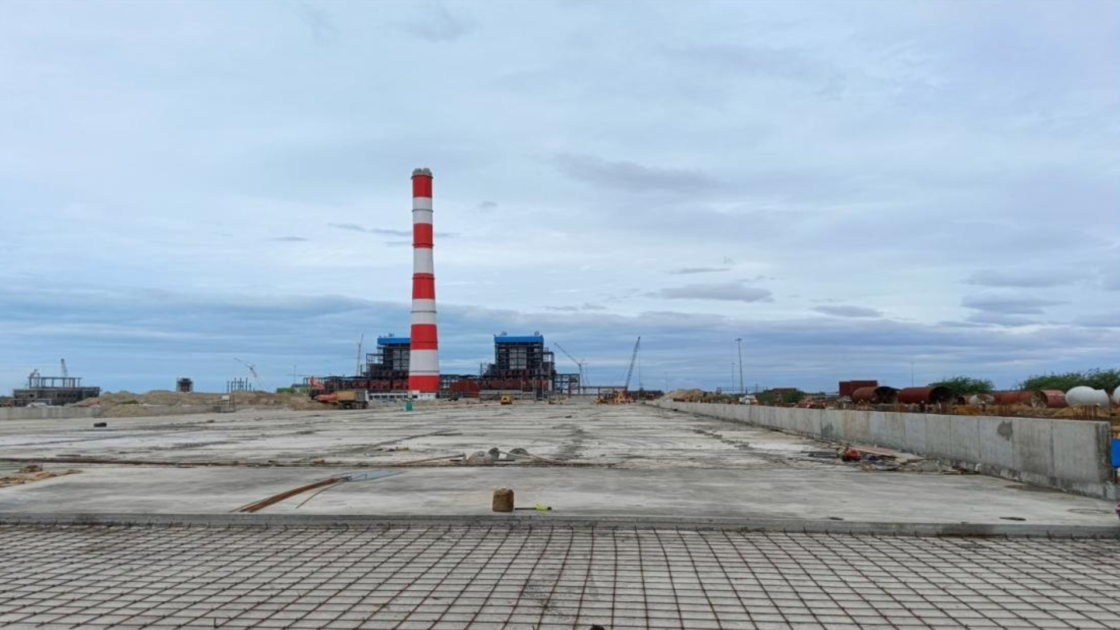Author: PPD Team Date: 20/02/2025

The 1,320 MW (2X660 MW) Udangudi power plant is under construction in the Thoothukudi district of Tamil Nadu. Initially undertaken by Udangudi Power Corporation Limited (UPCL), a joint venture between Tamil Nadu Electricity Board (TNEB) and Bharat Heavy Electricals Limited (BHEL), the project was later transferred entirely to Tamil Nadu Generation and Distribution Corporation Limited (TANGEDCO) following BHEL’s exit. The project’s original capacity of 1,600 MW (2X800 MW) was revised to 1,320 MW.
The plant employs supercritical technology to qualify for benefits under the Clean Development Mechanism (CDM). A distinguishing feature of this project is its own captive coal jetty at Udangudi, which facilitates coal transportation through a pipe conveyor system. The power plant requires approximately 13,790 cubic meters per hour (m3/hr) of seawater for operations. The generated power will be evacuated via the 765 kV Tuticorin pooling substation of Power Grid Corporation of India Limited (PGCIL).
Coal Supply and Fuel Sources
The plant will use 2.246 million tonnes per annum (MTPA) of imported coal from Indonesia and 3.647 MTPA of indigenous coal from Odisha (Talcher). TANGEDCO has entered into an agreement with MMTC for the supply of imported coal. As per the Ministry of Environment, Forest and Climate Change (MoEF&CC) requirements, the calorific value of the imported coal must be at least 6000 kcal/kg. Additionally, TANGEDCO is approaching MoEF&CC for necessary modifications in the environmental clearance (EC) to allow the blending of coal for the project.
Key Developments and Contract Awards
TANGEDCO invited multiple bids for the captive coal jetty, the latest being in March 2015. A consortium of ITD Cementation India Limited and China Railway Construction Corporation Limited (CRCC) was identified as the lowest bidder in June 2015, but the contract was not awarded.
In April 2013, TANGEDCO initiated bidding for the engineering, procurement, and construction (EPC) contract. However, the TNEB deferred the process due to a legal dispute between BHEL and CSEPDI-TRISHE (a consortium company of Central Southern China Electric Power Design Institute and Trishe Energy Infrastructure Services) regarding another power project in Ennore. In April 2015, the Tamil Nadu government revised the bidding conditions, shifting from a debt-financed model to a contractor-for-hire approach. However, the Madras High Court later restrained TANGEDCO from issuing fresh bids following a petition by an Indo-Chinese consortium.
On March 16, 2017, the Expert Appraisal Committee (EAC) of the MoEFCC recommended an amendment in EC for the revised 1,320 MW capacity.
Following a dismissal of the petition against TANGEDCO by the Madras High Court on December 7, 2017, BHEL secured the Rs 73 billion EPC contract for the project on December 15, 2017. This covered design, engineering, manufacturing, erection, commissioning, and civil works.
On January 12, 2018, REC signed a loan agreement of Rs 104.53 billion with TANGEDCO for the project, followed by the laying of the foundation stone by the Tamil Nadu government on January 29, 2018.
Subsequent Contracts and Developments
February 16, 2018: ITD Cementation India Limited received a Rs 19.03 billion contract for the captive coal jetty.
May 24, 2018: BHEL invited bids for power supply and area lighting. The contract was later awarded to Narmada Engineering Works.
July 3, 2018: GE Power India Limited won a Rs 1,264 million contract for boiler equipment supply.
October 6, 2018: Bygging India Limited secured a Rs 348 million contract for constructing a twin steel flue RCC chimney.
October 16, 2018: Tata Consulting Engineers Limited (TCE) won a Rs 236.19 million contract for project management consultancy.
December 2018: Several contracts were awarded, including Rs 510 million to Sree Saravana Engineering Bhavani Private Limited for levelling and grading, and Rs 212.6 million to Priya Construction for boundary wall construction.
January 2019: BHEL invited bids for erection and commissioning of ESP and its auxiliaries.
May 9, 2019: Coastal Marine Construction & Engineering Limited won a Rs 2,934.7 million contract for seawater intake and outfall system construction.
June 2019: Multiple contracts were awarded to B&B Developers & Builders Private Limited, RPP Infra Projects Limited, and Elecon Engineering Company Limited for civil, architectural, and mechanical works.
December 2019: Gammon Engineers and Contractors Private Limited secured a Rs 1,659.5 million contract for constructing natural draught cooling towers.
January 2020: Gannon Dunkerley and Company Limited won a Rs 2,589 million contract for main plant area civil works.
September 2020 – March 2022: Additional contracts were awarded for balance works, power cycle piping, cooling water piping, and commissioning support.
Recent Environmental Developments
According to the agenda for the Expert Appraisal Committee’s late June 2024 meeting, TANGEDCO had submitted a proposal for fresh Terms of Reference (ToR) for Stage I of the Udangudi power station. A fresh ToR was needed as ongoing physical work on Stage I was reportedly 83% complete under the existing EC, which was nearing the end of its valid term. In addition, TANGEDCO planned to propose a reduction in the plant’s use of imported coal. The EAC subsequently recommended issuing fresh ToR for Stage I. A ToR certificate was issued in July 2024.
Conclusion
The Udangudi Power Project has faced multiple delays due to legal and procedural challenges. However, with critical contracts awarded and financing secured, construction and development are progressing steadily. Currently, 88 per cent and 87 per cent of physical progress has been reported in Unit I and Unit II, respectively. Unit I is expected to commission by March 2025 while Unit II is expected to commission by May 2025. The project’s completion is expected to significantly enhance Tamil Nadu’s power generation capacity, contributing to the state’s growing energy demand.
Photo credit: BHEL
